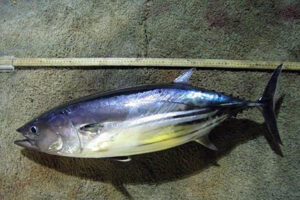The fish cannot seem to make up their minds about where they want to be for more than a day at a time. It looked like they were settling in at Beach Point, and then they completely vacated the area. After that they showed up from Race Point to the Race Station for a day, and then, just like that, they left there as well.
As soon as we think they have settled down, they’re off to another area. This suggests that the number of fish in our area is not very high right now. The stretch of bay between Wood End Light and Race Point Light, which for years has been the go-to area in June, has been noticeably dead so far this season. Trolling umbrella rigs and Jig-N-Eels have been more effective than drifting baits and casting lures.
The rest of the bay has also been pretty quiet. A few bass were caught around the Herring Cove bathhouse for a day or so, but that’s been about it. Bluefish have been here today and gone tomorrow, too. We caught some big ones at Herring Cove, but the next day they were gone. Mackerel have all left the bay and are way up on Stellwagen Bank almost out of range for us to shoot up with a center console boat to get bait for upcoming trips.

On the upside, flounder fishing remains good down in the bay by the #1 buoy off Sesuit Harbor. And schoolie tuna have shown up around Peaked Hill and north of Race Point and were seen busting the surface with a few being caught by trolling squid rigs and casting big poppers. Most of these fish have been in the 50- to 80-pound range.
There’s also good news for whale watchers: the whales have returned from wherever they were to Stellwagen Bank and have been providing a good show. The usual pack of fin whales who cruise and feed in the Race Point area has yet to show this summer, but we’ll keep an eye out for them every day that we are out.
The other thing we should all have an eye on is the situation going on in the waters south of us — all things being connected, this is critical to understanding what will eventually affect us here on the Cape.
We all know by now that the Atlantic has been steadily warming overall. Now, a severe marine heat wave has developed in the Caribbean Sea and Gulf of Mexico and off the Florida coast this month, where water temperatures are reaching the low 90° F mark, some 5 to 8 degrees higher than normal. The Florida Keys and the Bahamas are under a NOAA bleaching warning brought about by these record-high temperatures. High water temperatures place enormous stress on coral reefs and other marine ecosystems, and as the coral dies off it loses its color. This means, of course, a loss of habitat that supports fish and other marine life.
These record temperatures, besides killing coral, will also fuel stronger hurricanes. Colin McCarthy, the atmospheric science student at U.C. Davis who with his US Stormwatch social media account has become one of the most followed weather analysts in the country, puts it in simple terms: “Just a 2° F rise in sea surface temperatures can increase a hurricane’s wind speeds by over 13 percent,” he told Newsweek in a June 3 interview. “This means a 140 m.p.h. Category 4 hurricane can become a 160 m.p.h. Category 5 (in favorable atmospheric conditions), with nearly 3 times the damage potential.”
Add to all this a La Niña creating favorable conditions for hurricane development, and NOAA has issued its most aggressive hurricane season forecast on record for 2024.
As for what’s happening in our marine environment right now, we already have 70-degree surface temperatures in the bay. The first bonito, a warm-water fish that typically doesn’t show up here until our waters hit peak highs in August, have already arrived and are being caught in the bay way ahead of schedule.



